Power Cords
Also referred to as electric cords, power cords can be used to transfer a direct electrical current (DC) or alternating electrical current (AC). Most cords are AC power cords that conduct energy in which the direction of current flow is periodically reversed. The power supply cord, or cable assembly, is a wire composed of a highly conductive material such as copper, surrounded by an insulative material, and then sealed in a protective outer jacket with a plug cover to ensure safety around the electrical outlet. In North America, NEMA power cords (National Electrical Manufacturers Association) are the standard for electrical plugs, cord voltage capabilities, and receptacle configuration. International power cords and plug adapters are used in conjunction with electrical appliances in countries different from those in which they were designed to operate. Cord sets are used in any application that requires the existence of electrical energy to fully operate, such as office space, industrial operations, medical machinery, and commercial appliances. For specialty equipment used in locations without a convenient power source, such as construction machinery, sound and lighting equipment, emergency medical defibrillators, and electrical power tools, extension cords carry the electrical current up to hundreds of feet away from an outlet.
Retailers, hospitals, most manufacturers, and virtually all businesses in the industrial world use power cords every day. Power cords are the path through which energy travels from a power supply to the machine. Experts rate power using volts (or kilovolts, kV, for larger quantities), so the potential of a specific cord is determined by how much power it can transport. When determining the appropriate power cord type to be used for different applications, there are many factors to be considered such as equipment location, duration of use, and the strain of the operation. Power cord manufacturers adhere to standard regulations for voltage ratings, current, wire diameter and length, jacket material, maximum cable temperature, as well as the type of molded plug and female receptacle to be used. The capability of a cord to successfully handle the required flow of electrical energy will depend on these factors, and the quality of electricity transmitted will be affected accordingly. Cord wire sizes and voltage capacities are designated according to the American Wire Gauge (AWG) standards. The appropriate wire size is therefore determined by the amount of voltage required to flow through the cord. Wire shape can be either flat or round according to whichever is more appropriate for the application. Jacket material is another consideration and may be determined by the intended use and location of the power cord. For example, if the cord is purposed for rugged, outdoor usage, a jacket material will be waterproof and more durable than a cord intended only for use indoors, as with a laptop computer. Another consideration for jackets is the possible existence of electromagnetic interference and whether or not the wires in a power cord require further protection, such as those used with medical equipment.
The National Electrical Manufacturers Association (NEMA) is responsible for setting the stringent standards used in North America for electrical supply components; this ensures a high quality of electrical supply is maintained. Other countries have their own voltage systems and electrical component layouts, and so those respective countries determine the standards and controls implemented in their power cords. Manufacturing standards, such as those enforced by NEMA, help to maintain consistency in power cord production and decrease the chance of malfunctions due to quality standards. As with any component used in the transferring of electrical power, there are important safety precautions to be undertaken in the use of power cords. Personal injury, death and/or extensive property damage can occur as the result of deterioration, malfunction, or misuse of electrical equipment, and it is important for there to be measures in place to reduce these risks. Polarization, or grounding, is a vital aspect of electrical plugs and appliances, especially for higher voltage appliances or for electrical equipment that has a higher risk of causing an electric shock when live. Sensitive electrical equipment and products should only be used with polarized or grounded cord sets. Other safety precautions for electrical supply components include plug covers, waterproof protective materials, fuses, and circuit breakers.
Quick links to Power Cord Information
History of the Power Cord
Thomas Edison developed the first power distribution system in 1882. He used a three-layer cord that consisted of a copper rod wrapped in a vegetable fiber (called jute) to form a bundle cable. Those two layers were then wrapped in a bituminous layer for protection.
Copper was used because it is a superior conductor of electricity. The other layers held the copper together, insulated it, and also provided a level of protection to people from the dangerous effects of electricity.
Vulcanized rubber soon replaced the bituminous layer. It is an effective insulator, which means it is not an effective conductor and can withstand higher temperatures than the bituminous layer.
The development of technology and new materials were developed better suited for electrical purposes. PVC, or Polyvinyl chloride, is now widely used for electrical cords. PVC is a plastic that can withstand higher temperatures, which makes PVC power cables efficient and safe.
How Power Cords Are Made
Power cord manufacturing can be broken down into three parts:
- Wire-Drawing
- Insulation
- Phase Wiring
We will outline the manufacturing process below using the example of copper wire. Aluminum conductor wire is sometimes used for certain applications. However, aluminum is not as good of a conductor as copper and is not as durable.
- Wire-Drawing
- Wire-drawing begins with the delivery of 5 ton coils of 8 mm diameter, copper, “wire rods.” The first step is to reduce the diameter to 2 mm to increase ductility and conductivity.
- The next step is to reduce that wire further into whatever specifications the particular application requires.
- The wires are then treated with heat to further increase ductility and conductivity lost when the wire was reduced from its original 8 mm size. This process is known as “annealing.”
- The wires are then “stranded,” or grouped into conductors.
- Insulation
- Extrusion techniques are used to coat the conductors in a protective coating that prevents current leakage. PVC cables are a common insulator, but there are also other suitable insulators, including:
- Cross-linked Polyethylene Cable(XLPE cable), which is often used for high voltage applications.
- Ethylene propylene(EPR cable), which offers increased durability and heat resistance. It is one of the most popular types of industrial wiring.
- The final part of the insulation process is testing. The entire cable is tested using high-voltage electricity to ensure that there are no leaks.
- Phase Wiring
- At the end of the process, the different conductors are grouped to make a multi-core cable. The phases are assigned a color or number based on the industry standards and grouped.
- After phase wiring, the entire cable is tested again to ensure it has the proper insulation.
Power Cord Features
Power cords are typically flexible (although, for certain uses, they can be semi-rigid) and consist of a cord with electrical plugs at each end: one male and one female. The female plug is connected to the piece of equipment or appliance while the male plug connects to the electrical receptacle or outlet.
When it comes to power cords, several features may come with the cords or could be added to your cord order. Some of these may include twist-locking abilities, which work to minimize the possibility of disconnection. For cords that are used in sensitive applications, or for audio/video equipment, a shield over power conductors will prevent electromagnetic interference. Other accessories include leakage current detectors, pilot lamps that indicate present voltage, and fuses that offer overcurrent protection.
Retaining clamps are another common feature offered in conjunction with power cords. These are mechanical devices that protect an appliance coupler from being accidentally pulled free. Retaining clamps, also referred to as safety lock devices, are common in situations where safety precautions are strict, such as medical devices, computing applications, and stage and lighting technology. Clamps are also often used when extension cords are employed, in which the current must be carried far from the source, as they ensure a secure connection no matter how the extension cord is maneuvered.
Another common feature for power cords is plug adapters. These are crucial accessories when it comes to using appliances in countries other than those they were created to be operated in. These, in combination with voltage converters, will ensure your electronic devices are protected from the harm that could come from varying voltages in other countries. Some companies may offer more features and accessories than others, so shop around and make sure you’re getting everything you need to operate your electronic equipment safely, efficiently, and economically.
How Power Cords Work
To understand how power cables work, it is useful to trace the flow of power from power suppliers to our homes and businesses.
Local power suppliers can connect to neighborhoods in a few different ways.
Overhead power lines transmit power through towns and cities throughout the world. This method of aerial power delivery is popular in suburban areas.
One method of overhead power transport is the use of aerial bundle cables (ABCs). ABCs have had some safety issues in many areas but a new, low voltage option might address those issues.
Subterranean power systems transmit power underground. An advantage of this is that they are not as affected by weather. There are no power lines directly exposed to wind or rain, so they last longer and are less likely to suffer power outages.
About 18% of America's power transmission equipment is underground. The main deterrent in underground power lines is cost. Many areas do not want to invest the large amount of money required to set underground lines up.
- From the Plant to Your Wall
- Power cords take energy, in the form of electrical current, from power supplies to various electronic devices. The power supply is typically a wall-mounted outlet. It can be extended a long distance with an extension cord and adapted for use by multiple devices using a power strip.
- Different devices use different power cords. Which cord is needed can depend on geography, the device's internal circuitry, or the power required.
- AC Power Cords
- Alternating current adapters are widely used in both home and commercial applications. Devices that need power but do not have the internal mechanisms to get power from a main supply use these cords.
- AC power cords are utilized for devices that remain stationary because the electricity provided from the electric grid is AC.
- DC Power Cords
- Direct current power is better suited for portable electronics, such as flashlights and cellular phones. A device that needs DC power must convert the outlet’s AC power using a rectifier. This rectifier changes the electricity into a form the DC cord can use.
- These are the sub-categories that exist under AC and DC power cords:
- Standard 2-Conductor Power Cord
- These cords are most often found on class 2 consumer electronics. They are compatible with the typical receptacles widely used in modern U.S construction. Standard 2-conductor power cords are low-cost and can be molded into a variety of colors. They can typically handle 10, 13, and 15 amp devices and a maximum of 120 volts.
- Standard 3-Conductor Power Cord
- These are also common power cords. They are used for devices such as light fixtures, heaters, air conditioners, and exercise equipment. They feature a ground pin that provides an increased level of safety.
- Locking Power Cords
- Locking power cords are used for applications in which a disruption of power would be devastating. For example, IT settings use them so their system’s power is not interrupted.
- Healthcare Approved Power Cords
- In hospital applications, proper power can mean the difference between life and death. For this reason, they require a very durable, dependable, hospital-grade power cord.
- These cord cables are put through a rigorous series of tests to verify they can handle the needs of the medical environment. Their durability and conductivity must be of the highest quality. They are highly scrutinized before being approved for use.
- Power cords do not work alone. Many accessories can improve performance and safety.
- Here are items that expand or improve the performance of electrical cords:
- Plug Adapters
- These are vital for anyone who travels. International power cords vary, so it is important to bring the correct plug adapter for travels abroad. These ensure your electronics will work safely in a different country.
- Control Cables
- As the name implies, these are the cables that send and receive information from the control unit to the different parts of a device. They work similarly to the nerves within humans.
Points to Consider When Buying a Generator Power Cord
Uninterrupted power supply is a dream that never actually comes true. This is sometimes due to a fault in the line. Often, it is because of unusual, harsh weather conditions. It is possible, though it happens rarely, for the power supply of your home or your entire area to be disrupted. Under such circumstances, many Americans rely on power backups that include a centralized generator and solar power standby.
For smooth and unbarred generator function, you need to be familiar with a series of generator power cords. A generator cord is a classification of cord sets that come with portable generators. Buying it and properly using it are two problems homeowners face. Even those who are familiar with generators may experience confusion while connecting the machine with the main supply.
- Common Types of Generator Cords
- The most common variations of generator cords are TT, 5, L5, 14, L14, and CS. There are also a few other varieties you can find online or at a nearby store.
- What does this specific labeling signify?
- Labeling depicts the receptacle and plug type. If you see only numbers on the labeling, that means the cord set is a combination of slotted and easily loosened plug or receptacle. If the labeling has a character (for example, L), then that means the cord has a twist lock, and it can be inserted, locked, and used to prevent accidental disconnection. You can find various other definitions of these labels on the internet.
- However, on the most recent packaging of cords, you will find that the manufacturer may only highlight the amperage, plug type, and receptacle end type in bold characters.
- The Gauge of the Cord
- This information refers to the electrical conductors that your cord is compatible with. The lower the figure is, the thicker and stronger your cord will be. For example, 10 gauge is taken as the lowest number, and that is largely used with portable generators.
- Strong Connectors
- You should invest in robust, high-performance generator power cords. Branded ones are considered ideal as they go through rounds of product testing and come with a guarantee. Further, heavy-duty cords have strong connectors that ensure unremitting power backup at your home and the continuance of your business.
- Generator power cords integrated with smart technologies, such as plugs, connectors, and LED-powered indicators, are considered ideal in terms of user and appliance safety.
- Generator Cord Safety
- It is not safe to use a brand of cord not specifically made for your generator. Additionally, it might not be an adequate mate for your engine. For the safety of users, it is vital to get first-rate quality cords produced by a renowned brand. You need to be extra careful when working on the power output to avoid accidents to you or your appliances.
How to Choose the Right Power Cord
Before purchasing a power cable, you must identify your power needs and then find the cord that best meets those requirements.
The next step is to choose between the variety of manufacturers that are in the market. Customer testimonials are a good place to start, but it is important to be careful because your specific needs may differ from those of other customers.
Original Equipment Manufacturers (OEM) power cords are made by one company and marketed and sold by another. OEM custom power cords can be a solid option, but it is important to research the original manufacturer, as well as the company whose name is on it. This will ensure that the customer knows what they are getting. Sometimes the manufacturer of the power cord is not the same as the name on the packaging of that cord.
It is also important to understand the needs of the device to which it will provide power. The cord for a computer will probably not work as a cord for a medical device. Safety is as important as function. The wrong cord, used over time, may destroy the electric components of your device, or even pose a dangerous hazard to a home or office. Any reputable cord manufacturer will feature the 'UL' insignia (or another trusted testing agency's mark). This means the cord has been tested for safety and efficiency to make sure it will function properly.
Extension cord sets are convenient for households and commercial and industrial businesses. There are many options when it comes to purchasing cord sets, including variations in design and capacity. With so many options, it is easy for anyone to get confused over choosing the right power cord or extension cord set for their application.
Here are some tips to help you choose the right cord set:
- If you are looking for a cord extension set for your table lamp, consider buying an 18-gauge cord set that has two prongs suitable for light-duty usage. A cord set with these specifications and a cable folding system are ideal utilities for bedroom and study room table lamps.
- For laptops, a three-prong cord set with fourteen gauges is suitable. However, this power equipment can also be used for general purposes, such as table lamps and music systems.
- Toasters are electric appliances with an average wattage of 1 Horse Power (HP) or 750 watts. Many other kitchen appliances, such as a coffee maker or boiler, have similar wattage. For such heavy usage, it is recommended not to use an extension board. However, if you want to, you should choose a board that can meet this heavy requirement. The power cord for these devices should be able to support a current of at least 12 amperes. Make sure you place this equipment away from the sink or tap, as contact with water could cause severe damage.
- Hairdryers should be directly connected to the power board. They require 15 amps current. Because of this, they should not be connected to an extension cord set.
- Treadmills have become a common item for homes. They are heavyweight and they need a robust and dependable power supply. No manufacturer recommends using an extension cord with your treadmill. However, due to a lack of space, you can use extension boards purposely designed to work with your treadmill.
- Vacuum cleaners come with an extended cable option. If you want to extend the coverage of your machine, you can pick a three-prong and 12-gauge cord set for an outdoor vacuum cleaner. Also, make sure that the extension equipment comes with a plug locking system, as the plug of a vacuuming machine often gets pulled out while you are using it. For an indoor vacuum cleaner, a cord set with 16 gauges would be an appropriate choice.
- Room heaters are a high-power-consuming application. Ideally, you should not use them with any sort of extension. You should directly connect them to a wall unit.
- For holiday lights, if you need a cord set longer than 20 feet, it should have a 16-gauge cord. For anything less than that length, you can go with a set with a 14-gauge cord.
- For television, home theater systems, and other medium-capacity home appliances, you can use the cord with three prongs and 14 gauges. It is medium-duty equipment, suitable for many home appliances.
Do’s and Don’ts to Follow with Power Cord Sets
Since cord sets are electric appliances, they need to be handled with extra care to avoid accidents.
Do's:
- Frequently check for damage. Damage to the cable (such as tearing where the metal part is coming out or showing) could be a threat to the user. You should check every time before you use the cable. You should use tape to cover the openings and joints the cable has.
- Check if the equipment has a tested mark. All electric appliances go through various rounds of testing. The packaging and sometimes the body of the equipment have a hologram sticker of verification. You should check the sticker before making the purchase.
- Connect the plugs properly. Accidents can happen because of wrongly connected plugs and sockets. You should be sure you have properly connected the duo before turning on the switch. Fully inserting the plug also decreases the chances of short-circuiting and sparking from the board.
- Keep the extension board away from water. This is the most important step toward increased safety. It is never recommended to keep your power cord set in a moist environment or near a stream of water, even if the cord is not in use.
- Unplug the cord when not in use. Even if the power supply is off, the electric current may still be there in the sockets of the board.
- Repair the cord at the first sign of damage (if repair is possible). Discard the cord if it is not able to be safely repaired.
Don'ts:
- Never overload the cord set. There are different capacities of power cords. You should never use an appliance that is more than the capacity of your cord set. This way, you can prolong their life.
- Do not use indoor, light-duty cords for outdoor applications. Outdoor cords are designed to be suitable for heavyweight appliances and use in outdoor areas. Using outdoor cords inside may result in circuit damage.
- Do not forcefully insert the plug into the socket. You should never push or pull in/out the plug from the socket. Be gentle with the plug. By applying heavy force, you could break the board.
- Do not walk over the cord. Walking over it can break the metal wires inside of it.
- Do not play with or swing the cord. Do not bend or contort the cord unnecessarily. Doing this could lead to the short-term durability of the cord.
Power Cord Images, Diagrams and Visual Concepts
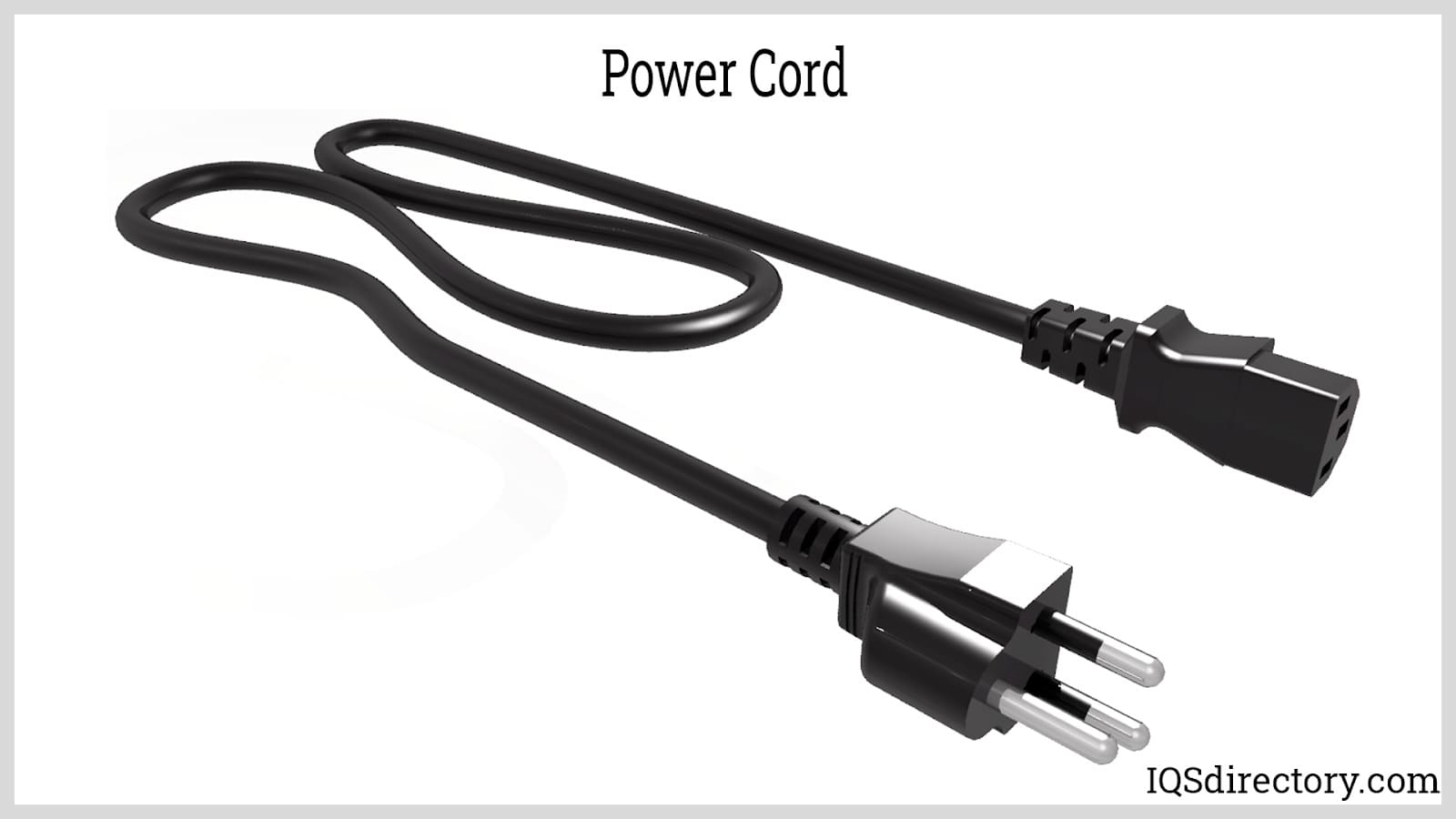 A power cord is a component used for connecting appliances to a power supply.
A power cord is a component used for connecting appliances to a power supply.
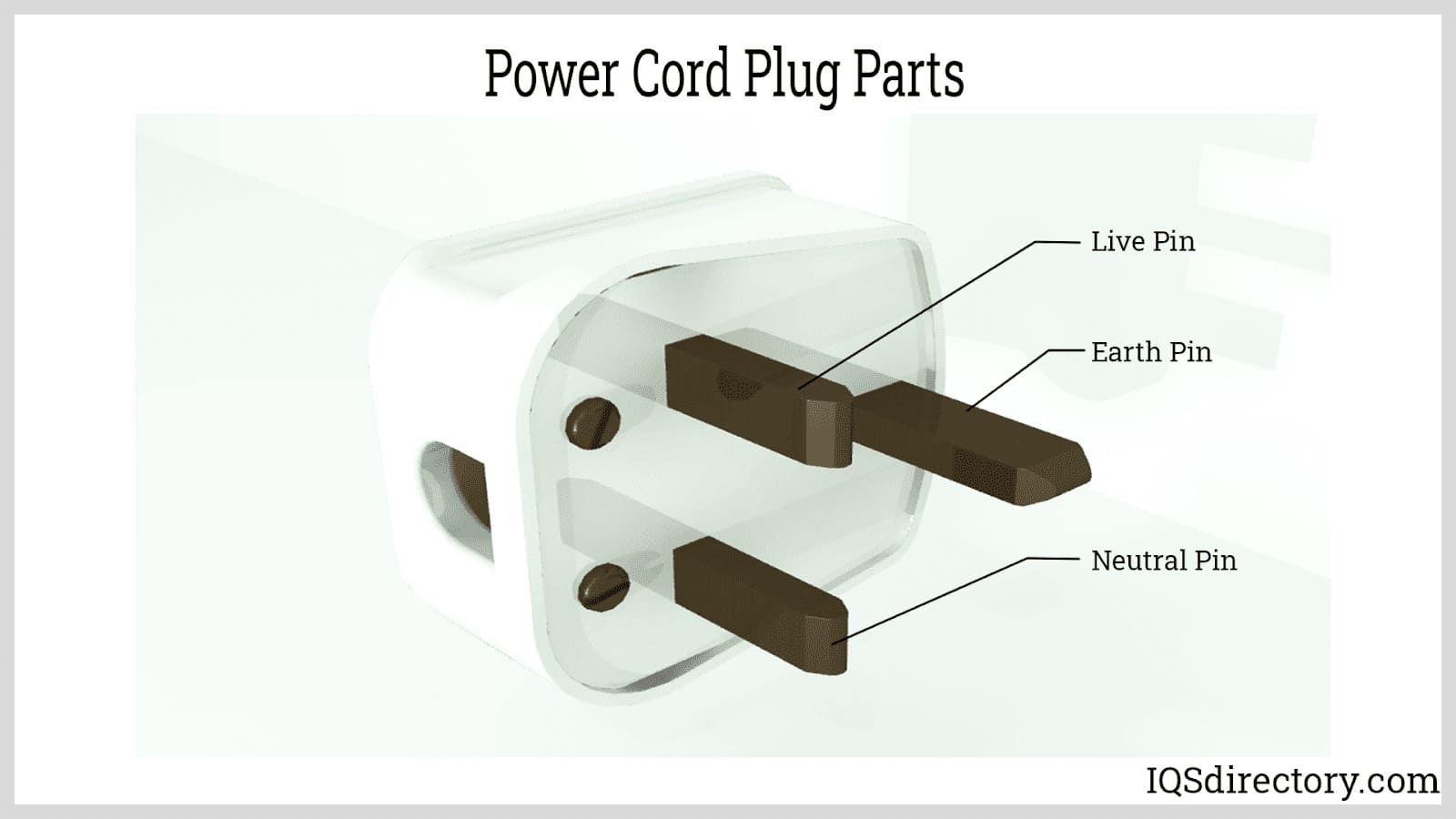 The pins consists of a live pin which connectos to the power supply, the earth pin which acts as grounding for the current, and the neutral pin provides a return path for the electrical current.
The pins consists of a live pin which connectos to the power supply, the earth pin which acts as grounding for the current, and the neutral pin provides a return path for the electrical current.
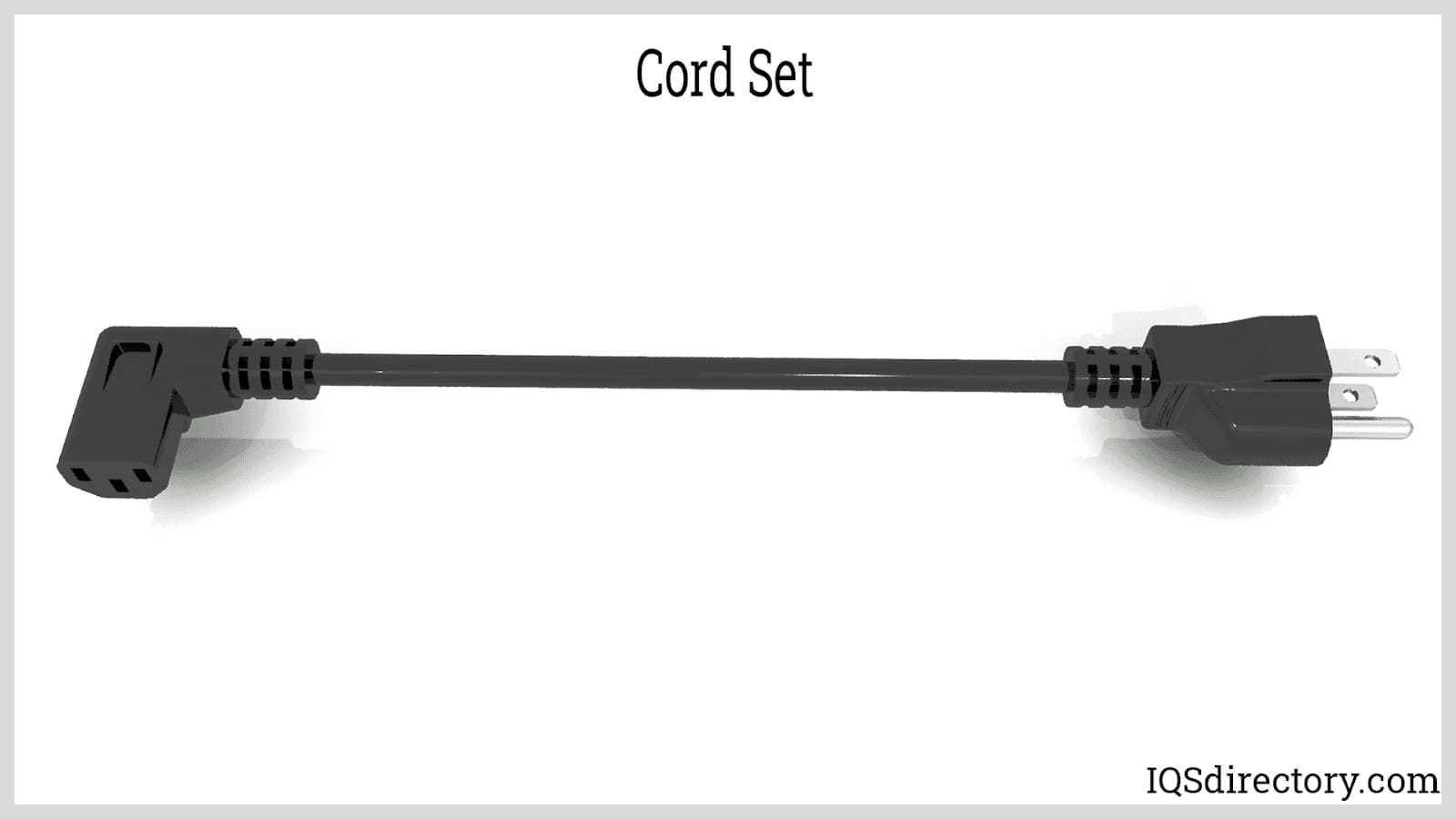 A cord set consists of a plug, a power cable, and a connector which are used for connecting an electrical appliance to an electrical utility.
A cord set consists of a plug, a power cable, and a connector which are used for connecting an electrical appliance to an electrical utility.
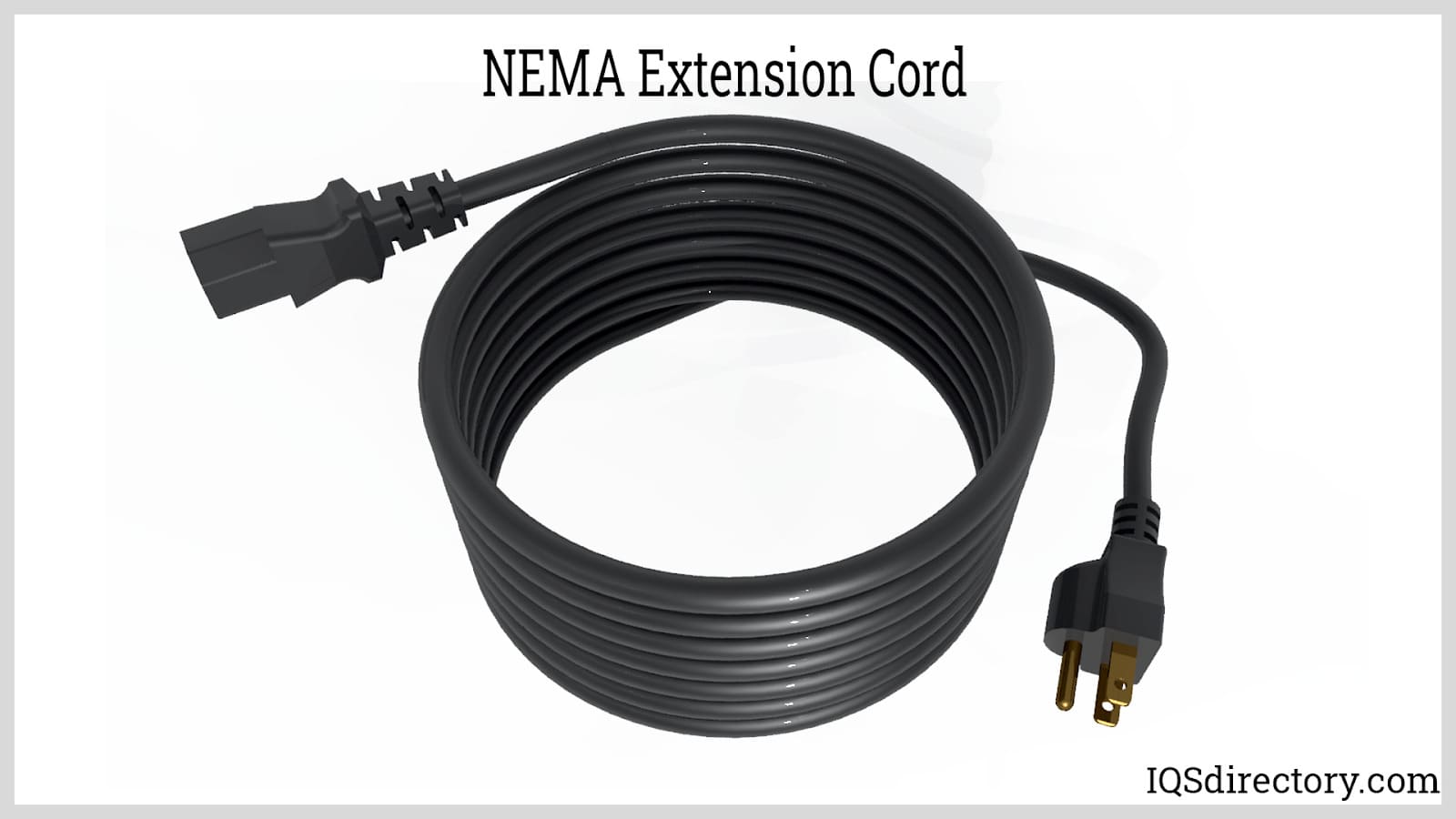 NEMA power cords are electrical cords which follow the specifications set by the National Electrical Manufacturers Association which are mainly used North America and some parts of South America
NEMA power cords are electrical cords which follow the specifications set by the National Electrical Manufacturers Association which are mainly used North America and some parts of South America
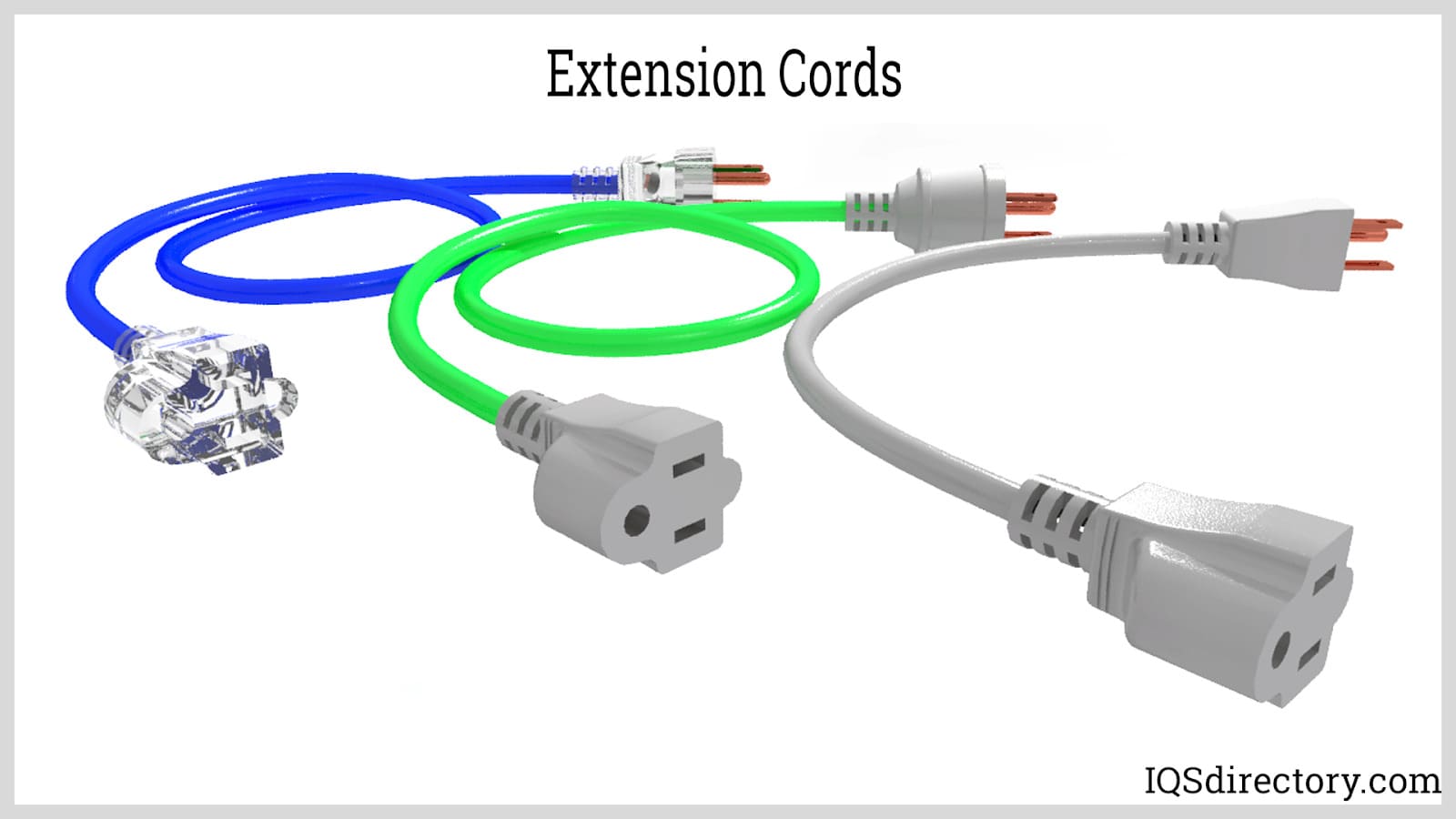 Extension cords are a cables that have a power plug and sockets to connect appliances to an electrical source.
Extension cords are a cables that have a power plug and sockets to connect appliances to an electrical source.
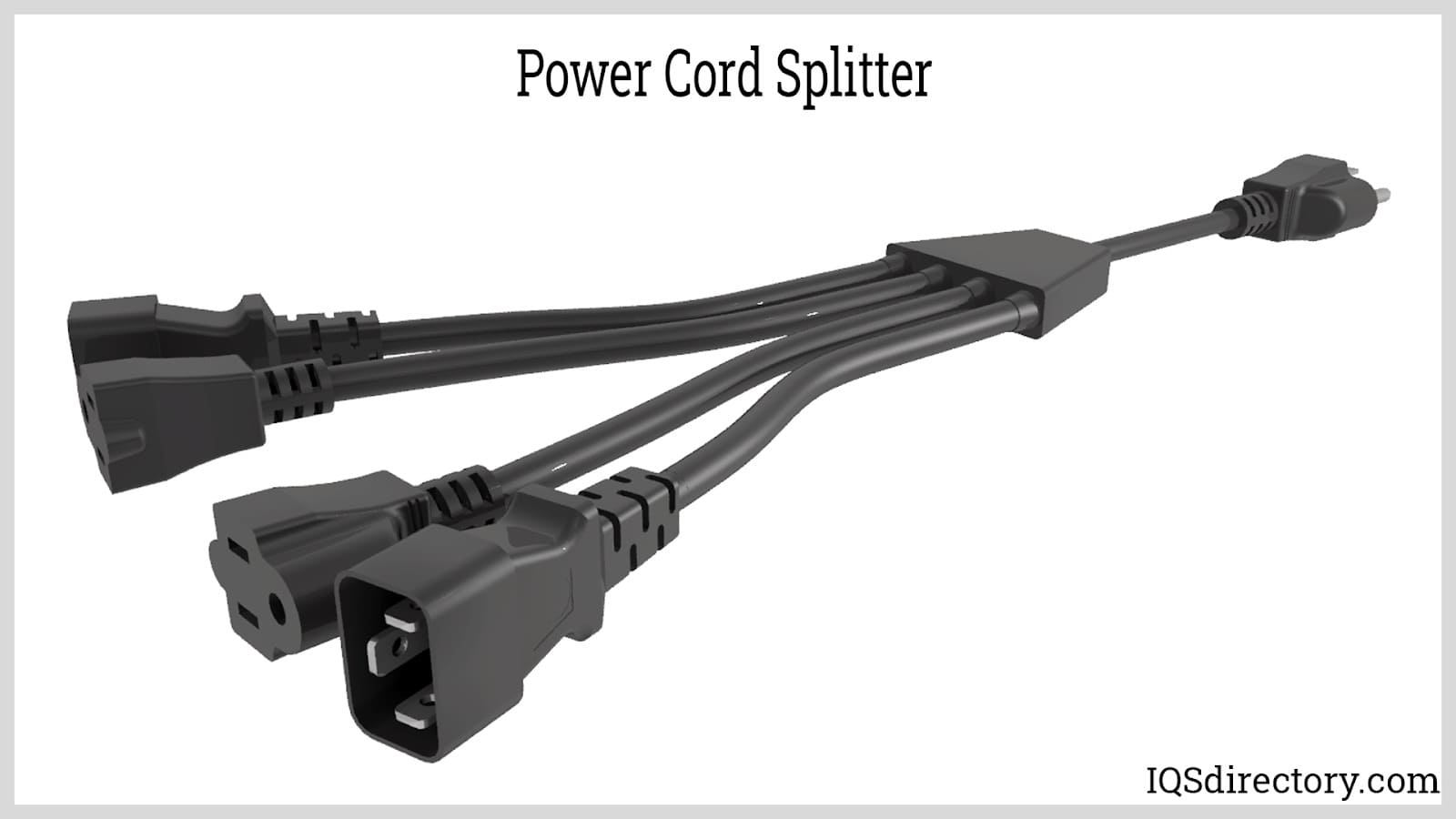 This allows for multiple appliances to be plugged in a single outlet.
This allows for multiple appliances to be plugged in a single outlet.
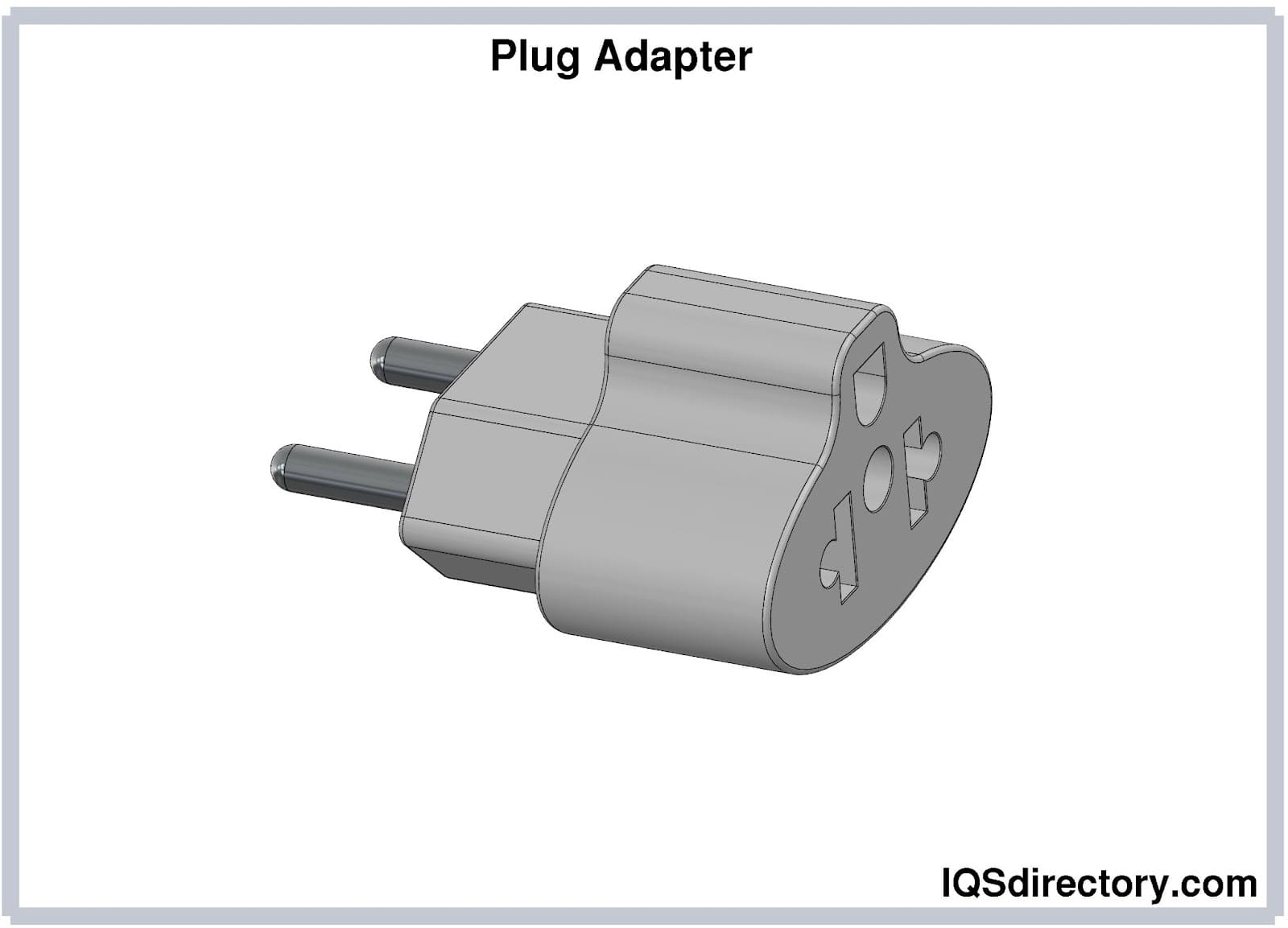 Plug adapters allow electrical devices to connect with sockets and plugs that are incompatible by converting voltage to what is required for the sockets or plugs.
Plug adapters allow electrical devices to connect with sockets and plugs that are incompatible by converting voltage to what is required for the sockets or plugs.
Power Cord Types
- AC Power Cords
- Conduct alternating current from one point to another. AC power cords consist of a conducting medium, typically copper, surrounded by insulation and a jacket.
- Business Machine Cords
- Used for computers and related electronic equipment.
- Cable Assemblies
- Consist of several wires or cables collected into a single unit with connectors on at least one end.
- Cord Covers
- Protective covers that guard loose cords and wires against hazardous situations.
- Cord Sets
- Power cords with a male electrical plug at one end and a female plug at the other.
- Electric Cords
- Conductive cables used to transfer AC power from a plug to an electrical device.
- Electrical Plugs
- Male electrical connectors with metal-blade contact prongs that connect electrically with holes in the matching female electrical receptacle.
- Electrical Receptacles
- Commonly known as outlets or sockets.
- Extension Cords
- Marked with the necessary information of their use, size, and wattage rating. Extension cords are available in many lengths and are marked with a size, or gauge, which is based on the American Wire Gauge (AWG) system.
- Heavy Duty Cords
- Specially designed for rough, heavy-usage environments in industrial or commercial applications. The head is constructed with large flats, which have deeply contoured ridges for a non-slip grip, and a heavy molded strain relief shroud, which protects the cord/plug union.
- Hospital Plugs
- Designed to meet the critical needs of medical equipment applications. Heavy-duty solid brass blades and pins are soldered or welded to the conductors for added durability.
- International Power Cords
- Detachable means of supplying electricity from a foreign power source to native electrical equipment or appliances that would otherwise be incompatible.
- NEMA Power Cords
- The standard for North American electrical plugs, cord voltage capacities, and electrical receptacle configuration.
- Polarized Plugs
- Have one blade wider than the other, which helps reduce the potential for shock. Three-prong plugs are automatically polarized since they can be inserted only one way.
- Power Supply Cords
- Flexible lengths of cord with an attachment plug molded to their ends. They are used to transmit electrical energy from the main supply to an electrical device. A power supply cord, which could also have terminations or a molded strain relief on the opposite end of the plug, is permanently installed in the device being powered, as opposed to a cord set, which is detachable.
- Plug Adapters
- Electrical devices that allow sockets to connect to plugs otherwise incompatible with each other.
- Plug Covers
- Provide protection against hazards, such as electrical shock, that result from uncovered electrical outlets.
- Right Angle Power Cord
- Sets allow users to plug in electrical equipment close to walls without bending or damaging power cords and are available in both a two-conductor (polarized or non-polarized) or three-conductor configuration. The three-conductor plug could have the grounding pin in the top or bottom location.
- Three-Conductor Plugs
- Have two vertical blades and a grounding pin. They are polarized by default since they can be plugged in just one way.
- Two-Conductor Plugs
- Consist of two vertical blades; one blade is neutral and the other is referred to as hot. Two-conductor plugs, which have no grounding pin, are either polarized or non-polarized.
Power Cord Terms
- Abrasion Resistance
- The ability of a power cable or material to resist surface wear.
- Alternating Current (AC)
- A current flow whose direction changes in regular cycles.
- American Wire Gauge (AWG)
- The North American standardized wire and cable-sizing system for identifying the wire diameter of copper conductors. The higher the gauge number, the smaller the cable.
- Ampacity
- The capability of handling electric current, as expressed in amperes. Also known as “current carrying capacity.”
- Arc Resistance
- The time it takes for an arc to create a conductive path in a material.
- Attenuation
- The loss of power in an electrical system. Expressed in decibels (dB) per unit length.
- Boot
- A protective layer covering any part of a conductor or cable, as well as its insulation or jacket.
- Braid
- A covering of one or more wires made from fibrous or metallic filaments interwoven in cylindrical form.
- Breakdown Voltage
- The amount of voltage at which the insulation between two conductors or a conductor and ground deteriorates.
- Bunch Stranding
- The twisting of wires together within the same frequency to achieve a specific gauge.
- Cold Flow
- Irreversible damage of insulation due to the mechanical force of pressure.
- Conductivity
- The capability of any material to carry an electrical charge, typically expressed in terms of the percentage of conductivity of copper, which has 100% conductivity.
- Conductor
- Any material in which electrons can freely move from atom to atom (i.e. electrical current flow). A conductor, which is usually metal, could be solid wire or a stranded multi-wire cable.
- Conduit
- A tube or trough through which wires and cables are run.
- Continuity Check
- A test used to determine if an electrical current will flow continuously throughout the length of a wire or cable.
- Cord
- A small insulated flexible cable made to withstand mechanical abuse.
- Dielectric
- An insulating material used in a cable to shield one conductor from another.
- Direct Current (DC)
- Electric current that flows in one direction only.
- Electrical Circuit
- The complete path of an electrical current. An electrical circuit is considered to be an open circuit when the continuity is broken and a closed circuit when continuity is maintained.
- Europlug
- An international plug used by many European countries. Europlug is the common name for the CEE 7/16 2.5 amp, Class II plug.
- Farad
- A unit of electrical capacity.
- Fatigue Resistance
- Resistance to the crystallization of metal, eventually leading to the breakage of conductors and wires due to flexing.
- Flanged Inlets/Outlets
- A flanged nylon housing that permits mounting in a panel on the front of the equipment for an electrical inlet or outlet. It is held in place by screws and bolts.
- Frequency
- The number of times an alternating current repeats its cycle in one second, measured in Hertz (Hz). The standard international frequency is 50Hz, while the standard North American frequency is 60Hz.
- Gauge
- An indication of the physical size of a wire or the wire diameter specifications. The larger the wire, the smaller the gauge number.
- Ground
- A complete circuit accomplished through a conductive connection between an electrical circuit and the earth or another large conducting body.
- Hi-pot
- A test applied to a cable to determine whether any damage has occurred during shipment.
- High Voltage
- Generally considered to be any operating voltage over 600 volts.
- IEC 60320
- Formerly “IEC 320,” it is the International Electrotechnical Commission standard that applies to a series of connectors, plugs, outlets, and inlets designed for use on electrical or electronic equipment, including such portable equipment as computers, printers, and medical equipment.
- Insulated Wire
- A conductor of electricity covered by a non-conducting material.
- Insulation
- Any material having high resistance to the flow of electric current that protects the inner conductors of an electrical cord.
- Jacket
- Material, usually extruded plastic or elastomer, that covers wire and cable, providing protection and additional insulation.
- Line Cord
- A cord that has a plug at one end and is utilized for connecting equipment to a power outlet.
- Loss
- The dissipation of energy without accomplishing useful work.
- Molded Plug
- A connector molded on one or both ends of a cable or cord.
- Multiconductor
- A cord or cable complex containing more than one conductor.
- National Electric Code (NEC)
- A compilation of wiring practices and requirements from the National Fire Protection Association (NFPA).
- Neoprene
- A synthetic rubber with good resistance to chemicals, oil, and flame. Also called “polychloroprene.”
- Nylon
- An abrasion-resistant thermoplastic with effective chemical resistance. It is utilized for cable and wire jacketing, wiring devices, connectors, and plugs.
- Ohm
- A unit of measurement referring to electrical resistance.
- Outlet
- A female connection that supplies access to electricity from a source of power.
- Pin and Sleeve
- A receptacle, connector, or plug that has round pins or sleeve-type contacts.
- Plug
- The cable mount portion of an electrical connection or male contact device that has pins or blades protruding from the face. Also called an “attachment plug.”
- Power cord splitter
- Allows the plugging in of two or more machines or tools into a single outlet.
- Sheath
- The material that is applied to the outermost part of a wire or cable. Sheaths are typically made of extruded plastic or elastomer. Often referred to as a jacket.
- Shield
- In cables, a metallic layer that prevents electrostatic or electromagnetic interference between wires and external fields when placed around a conductor or group of conductors.
- Signal
- An information-conveying current, including digital, analog, audio, and video information.
- Single Phase
- An electrical circuit that has a neutral, a line, and a ground.
- Socket
- A device that establishes an electrical connection with plugs through tension connections. Sockets could be metal contacts that are either bent to receive the blade or pin or are spring-loaded.
- Surge
- The temporary and relatively large increase in the voltage in an electric circuit or cable. Also called a “transient.”
- Three-phase
- An electrical circuit that holds three lines and a ground or three lines, a neutral, and a ground. The three lines are 1201/4 out of phase with each other.
- Voltage Rating
- The maximum voltage that can be continuously applied to a wire in conformance to standards or specifications.
- VW-1
- A rating established by UL for wire and cables that pass a specifically designed vertical flame test for flammability. Formerly designated as “FR-1.”
- W
- Any cord designated by Underwriters Laboratories, Inc. (UL) for outdoor use.
- Watt
- A unit of measurement that refers to electric power.
- Wire Gauge
- Any standard system of numerical designations for wire sizes (e.g. the AWG).